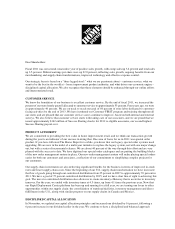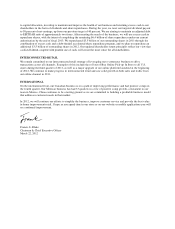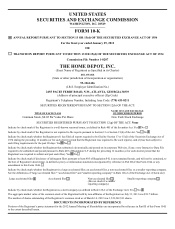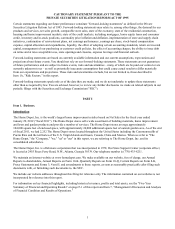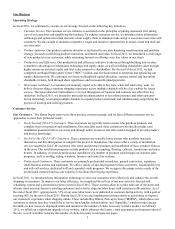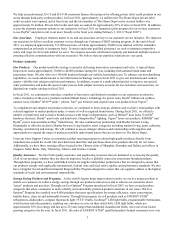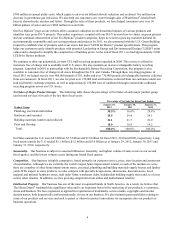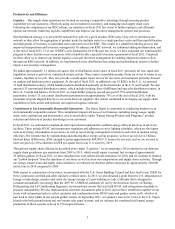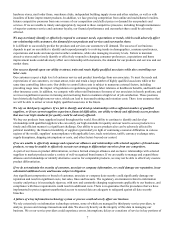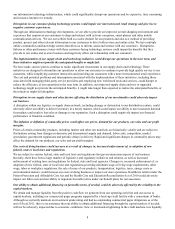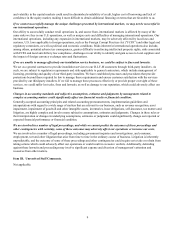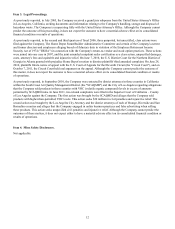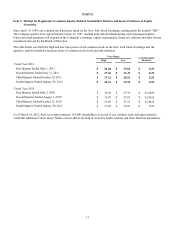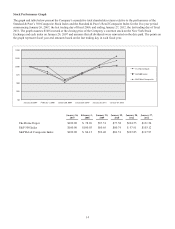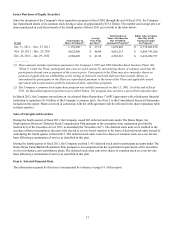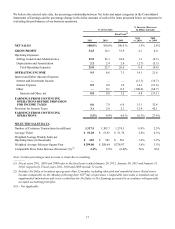Home Depot 2011 Annual Report Download - page 13
Download and view the complete annual report
Please find page 13 of the 2011 Home Depot annual report below. You can navigate through the pages in the report by either clicking on the pages listed below, or by using the keyword search tool below to find specific information within the annual report.
7
hardware stores, mail order firms, warehouse clubs, independent building supply stores and other retailers, as well as with
installers of home improvement products. In addition, we face growing competition from online and multichannel retailers.
Intense competitive pressures from one or more of our competitors could affect prices or demand for our products and
services. If we are unable to timely and appropriately respond to these competitive pressures, including through maintenance
of superior customer service and customer loyalty, our financial performance and our market share could be adversely
affected.
We may not timely identify or effectively respond to consumer needs, expectations or trends, which could adversely affect
our relationship with customers, the demand for our products and services and our market share.
It is difficult to successfully predict the products and services our customers will demand. The success of our business
depends in part on our ability to identify and respond promptly to evolving trends in demographics, consumer preferences,
expectations and needs and unexpected weather conditions, while also managing inventory levels. Failure to maintain
attractive stores and to timely identify or effectively respond to changing consumer preferences, expectations and home
improvement needs could adversely affect our relationship with customers, the demand for our products and services and our
market share.
Our success depends upon our ability to attract, train and retain highly qualified associates while also controlling our
labor costs.
Our customers expect a high level of customer service and product knowledge from our associates. To meet the needs and
expectations of our customers, we must attract, train and retain a large number of highly qualified associates while at the
same time controlling labor costs. Our ability to control labor costs is subject to numerous external factors, including
prevailing wage rates, the impact of legislation or regulations governing labor relations or healthcare benefits, and health and
other insurance costs. In addition, we compete with other retail businesses for many of our associates in hourly positions, and
we invest significant resources in training and motivating them to maintain a high level of job satisfaction. These positions
have historically had high turnover rates, which can lead to increased training and retention costs. There is no assurance that
we will be able to attract or retain highly qualified associates in the future.
We rely on third party suppliers. If we fail to identify and develop relationships with a sufficient number of qualified
suppliers, or if our current suppliers experience financial difficulties, our ability to timely and efficiently access products
that meet our high standards for quality could be adversely affected.
We buy our products from suppliers located throughout the world. Our ability to continue to identify and develop
relationships with qualified suppliers who can satisfy our high standards for quality and our need to access products in a
timely and efficient manner is a significant challenge. Our ability to access products also can be adversely affected by
political instability, the financial instability of suppliers (particularly in light of continuing economic difficulties in various
regions of the world), suppliers’ noncompliance with applicable laws, trade restrictions, tariffs, currency exchange rates,
supply disruptions, shipping interruptions or costs, and other factors beyond our control.
If we are unable to effectively manage and expand our alliances and relationships with selected suppliers of brand name
products, we may be unable to effectively execute our strategy to differentiate ourselves from our competitors.
As part of our focus on product differentiation, we have formed strategic alliances and exclusive relationships with selected
suppliers to market products under a variety of well-recognized brand names. If we are unable to manage and expand these
alliances and relationships or identify alternative sources for comparable products, we may not be able to effectively execute
product differentiation.
If we do not maintain the security of customer, associate or company information, we could damage our reputation, incur
substantial additional costs and become subject to litigation.
Any significant compromise or breach of customer, associate or company data security could significantly damage our
reputation and result in significant costs, lost sales, fines and lawsuits. The regulatory environment related to information
security and privacy is increasingly rigorous, with new and constantly changing requirements applicable to our business, and
compliance with those requirements could result in additional costs. There is no guarantee that the procedures that we have
implemented to protect against unauthorized access to secured data are adequate to safeguard against all data security
breaches.
A failure of a key information technology system or process could adversely affect our business.
We rely extensively on information technology systems, some of which are managed by third-party service providers, to
analyze, process and manage transactions and data. We also rely heavily on the integrity of this data in managing our
business. We or our service providers could experience errors, interruptions, delays or cessations of service in key portions of


